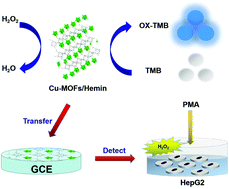Cu–MOF/hemin: a bionic enzyme with excellent dispersity for the determination of hydrogen peroxide released from living cells†
Abstract
The stability, repeatability and sensitivity of an electrochemical biosensor material are closely connected with the dispersibility of metal organic frameworks (MOFs) in aqueous media. Herein, a nanocomposite based on Cu–MOF/hemin, which is not only highly water-soluble but also simple and efficient in synthesis, was used for the construction of a non-enzymatic sensor to detect hydrogen peroxide (H2O2). The Cu–MOF/hemin was characterized via scanning electron microscopy (SEM), transmission electron microscopy (TEM), energy dispersive X-ray spectroscopy (EDS)-mapping, X-ray diffraction (XRD), Fourier transform infrared spectroscopy (FT-IR), X-ray photoelectron spectroscopy (XPS) and thermal gravimetric analysis (TGA), which indicate that hemin and the Cu–MOF were successfully combined. As a H2O2 electrochemical biomimetic enzyme, the Cu–MOF/hemin exhibited excellent electrocatalytic performance, which was confirmed by the electrochemical experiments and chromogenic reactions, and the possible mechanism of the reactions has been deduced. The electrochemical sensor based on the biomimetic enzyme exhibited an extended linear detection range from 0.01–5.0 mM (R = 0.998), low detection limit of 4.14 μM, and high selectivity and stability under the optimized conditions. More importantly, the practical application ability of the sensor was verified by the test of H2O2 in human serum samples and it could be used for the real-time detection of H2O2 released from living cells with satisfactory results. Therefore, this novel nanocomposite has certain potential in preparing electrochemical sensing platforms for nonenzymatic biosensing and provides a new method for clinical diagnosis and real-time monitoring.



 Please wait while we load your content...
Please wait while we load your content...